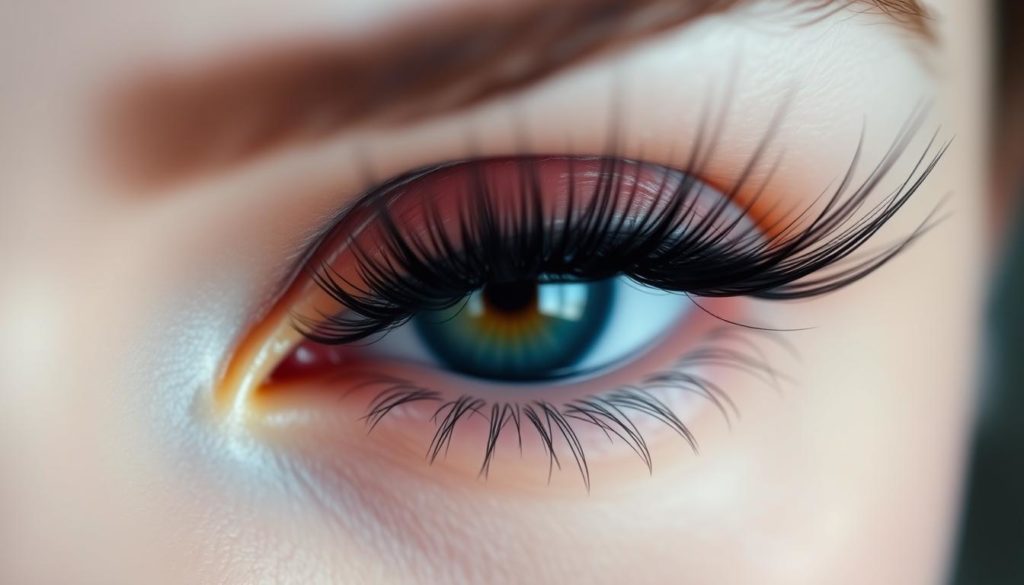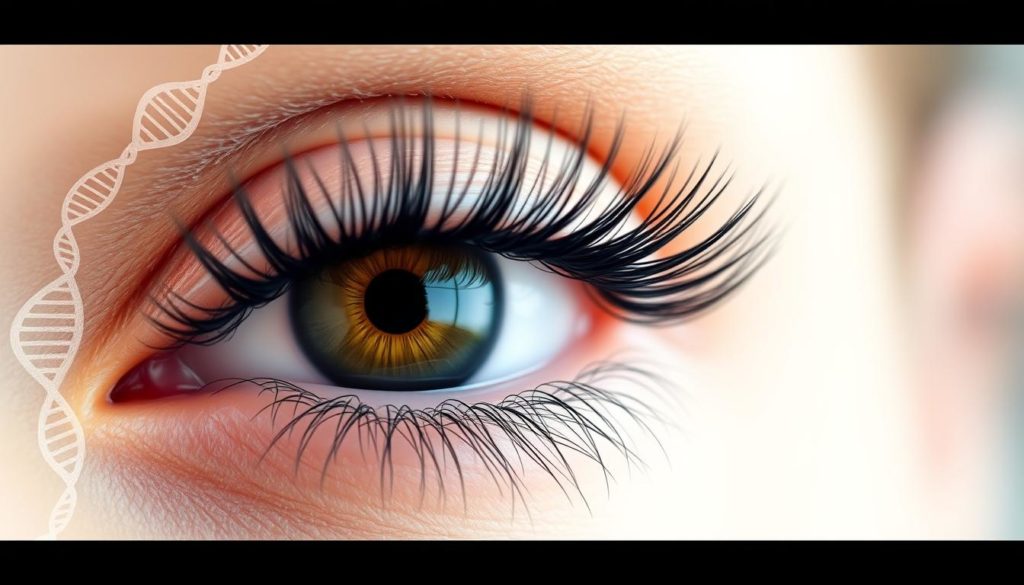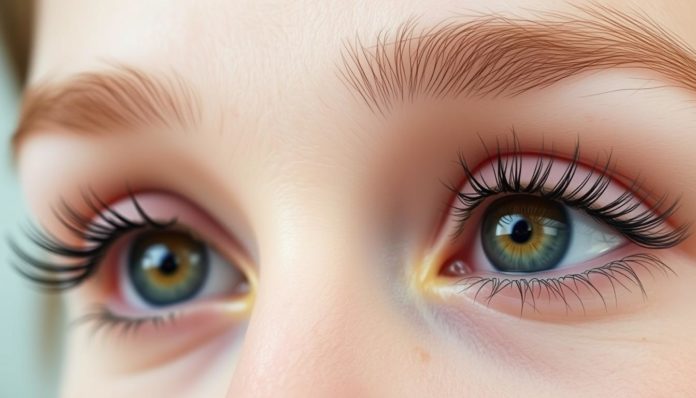Did you know only about 1 in 10,000 people have double eyelashes, also known as distichiasis? This rare eyelid disorder can cause a lot of discomfort. It also affects overall ocular health.
Abnormal eyelashes growing from the meibomian glands cause double eyelash syndrome. Knowing its causes, symptoms, and treatments is key to managing it well.
What is Double Eyelashes (Distichiasis)?
Double eyelashes, or distichiasis, is a rare eye condition. It happens when someone grows an extra row of eyelashes. This can change how eyelashes grow, creating a double row.
While some see it as a beauty boost, it’s key to know it can affect eye health.

Definition of Double Eyelashes
Double eyelashes mean an extra row of lashes from the meibomian glands. These glands usually make oils for the eyes. But, these extra lashes can sometimes rub against the eye, causing discomfort.
They are noticeable when you look closely. How visible they are can differ from person to person.
Medical Description of Distichiasis
Medically, distichiasis is about how these extra lashes grow. They can grow from the front of the eyelid, near the normal lashes. This can lead to eye problems like irritation and inflammation.
It can also cause damage to the cornea if not treated. This condition might be present at birth or develop later due to certain health issues.
| Characteristic | Normal Eyelash Growth | Double Eyelashes (Distichiasis) |
|---|---|---|
| Number of Eyelash Rows | Single | Double |
| Origin | Normal follicle growth | Meibomian glands |
| Potential Issues | Minimal | Irritation, inflammation, corneal damage |
Knowing about double eyelashes is important. It helps spot problems early and get the right treatment. Whether it’s from birth or develops later, seeing a doctor is the first step to managing it.
Common Causes of Distichiasis
Distichiasis, or double eyelashes, can come from different sources. Knowing the causes helps in managing and treating this eyelash disorder.
Genetic Factors
Genetic mutations are a main reason for distichiasis. This condition often runs in families, passed down from one parent. It’s linked to Lynphedema-distichiasis syndrome, which also includes lymphedema and double eyelashes.
Acquired Causes
Some people get distichiasis later in life, often due to eyelid inflammation or injury. Chronic blepharitis, or eyelid inflammation, can cause extra lashes. Even some surgeries on the eyelids might lead to this condition.
Associated Syndromes
Distichiasis can be part of a bigger syndrome. For example, Lynphedema-distichiasis syndrome includes swelling and double eyelashes. This shows how different genetic issues can affect the body, making a full diagnosis and treatment key.

Symptoms of Double Eyelashes
Distichiasis can cause many eye problems. Spotting these symptoms early helps manage the condition better.
At first, symptoms might seem minor. But, ignoring them can lead to serious issues. Common signs of distichiasis include:
- Eye Irritation: Feeling of discomfort or something in the eye is common.
- Redness: Eye redness often means the lashes are irritating the eye surface.
- Tearing: Too much tearing happens due to constant irritation from extra lashes.
- Swelling: Swelling and inflammation of the eyelids can occur as a reaction.
- Ulceration: Severe cases may cause corneal ulcers, which are painful and dangerous.
Any eye irritation or these symptoms need quick ophthalmologist check-ups to avoid lasting damage.
| Symptom | Severity | Notes |
|---|---|---|
| Eye Irritation | Mild to Severe | Constant feeling of discomfort |
| Redness | Moderate | Usually indicates rubbing |
| Tearing | Moderate | Excessive tearing due to irritation |
| Swelling | Mild to Moderate | Inflammation of the eyelids |
| Ulceration | Severe | Requires immediate medical attention |
How Double Eyelashes Affect Ocular Health
Double eyelashes, or distichiasis, can affect eye health a lot. It’s important to know the risks and complications. This helps prevent damage and keeps eyes healthy.
Potential Irritation
Double eyelashes can cause chronic eye irritation. The extra lashes can rub against the eye, causing discomfort and redness. If not treated, this can lead to worse problems.
Corneal Damage
Corneal damage is another big concern. Extra lashes rubbing against the cornea can cause abrasions. This can hurt the cornea, leading to pain and infection. Treating double eyelashes early can prevent these issues.
Impact on Vision
Double eyelashes can also harm vision. Constant rubbing against the eye can cause vision problems. Misaligned lashes can blur vision and lead to other issues if not treated.
Diagnosis of Distichiasis
Diagnosing double eyelashes, also known as distichiasis, is key to managing it well. The process includes a detailed clinical exam and specific tests.
Clinical Examination
An ophthalmologist will closely look at the patient’s eyelids and lashes during an exam. They use a slit-lamp examination to see the eye’s details. This test magnifies the eye structures, helping spot double eyelashes clearly.
Looking closely at the lashes under high magnification lets the doctor see how bad the condition is. They can also check for any eye irritation or scratches.
Diagnostic Tests
More tests might be needed for a complete eye condition diagnosis. These include:
- Fluorescein Eye Stain: A dye is put in the eye to show any corneal abrasions from eyelashes.
- Corneal Topography: This maps the cornea’s surface to find any damage or changes.
- Tear Film Stability Tests: These check the quality and stability of the tear film, which can be affected by irritation from double eyelashes.
By using these methods, doctors can make a detailed diagnosis. This ensures the best treatment options are chosen for relief and management.
Non-Surgical Treatments for Distichiasis
There are many non-invasive ways to treat double eyelashes without surgery. These options help reduce symptoms and prevent more problems.
Medications
Medicines can help with double eyelashes treatment, especially for inflammation and irritation. Eye drops and ointments keep your eyelids clean and ease symptoms. Always talk to a doctor to find the right medicine for you.
Protective Eyewear
Wearing protective eyewear is another good option. It keeps your eyes safe from the sun and dust. This makes managing distichiasis easier and lowers the chance of eye irritation.
Regular Monitoring
Seeing an eye care specialist regularly is key for treating double eyelashes. Regular visits help catch any worsening symptoms early. Keeping your eyelids clean and following a care plan can greatly improve your life with distichiasis.
| Treatment Option | Purpose | Advantages |
|---|---|---|
| Medications | Reducing inflammation and irritation | Non-invasive, maintains eyelid hygiene |
| Protective Eyewear | Shielding from environmental factors | Prevents additional irritation |
| Regular Monitoring | Early detection and prevention | Customized care, enhanced quality of life |
Surgical Treatments for Distichiasis
Surgical treatments are often the best choice for dealing with double eyelashes (distichiasis). These methods aim to remove or reduce excess eyelashes. This helps to ease discomfort and prevent eye damage.
Electrolysis
Eyelash electrolysis uses an electric current to destroy hair follicles. It’s a permanent solution for removing unwanted eyelashes. This method can take time, but the results last long.
Laser Ablation
Laser treatment for eyelashes is a modern option. It uses light energy to remove unwanted eyelashes. This method is less invasive and precise, making it popular among patients.
Surgical Removal
In severe cases, surgery is needed. Procedures like cryotherapy or eyelid resection can be used. These methods offer quick results but require a longer recovery and carry more risks.
| Method | Advantages | Disadvantages |
|---|---|---|
| Eyelash Electrolysis | Permanent solution, precise targeting | Time-consuming, initial discomfort |
| Laser Treatment for Eyelashes | Minimizes tissue trauma, precise | Requires specialized equipment, cost |
| Surgical Intervention | Immediate results | Longer recovery time, higher risk of complications |
Home Remedies and Care Tips
Dealing with double eyelashes can be tough. But, using some distichiasis home remedies and dry eyes treatment tips daily can help a lot. Here are some important strategies to try.
Warm Compress
A warm compress is a simple yet effective distichiasis home remedy. Use a clean, warm cloth to loosen debris and reduce irritation. Soak a cloth in warm water, wring it out, and place it over your closed eyes for 5-10 minutes. Do this several times a day for the best results.
Lubricating Eye Drops
Dry eyes treatment is key for those with double eyelashes. Over-the-counter lubricating eye drops can add much-needed moisture and relief. Choose preservative-free options to avoid irritation.
Hygiene Practices
Good eyelash care and eye hygiene are crucial with distichiasis. Clean your eyelids regularly with a mild, non-irritating cleanser. This removes oil, debris, and makeup, helping keep your eyelashes healthy and preventing infection.
| Remedy | Purpose | Instructions |
|---|---|---|
| Warm Compress | Relieve Irritation | Soak cloth in warm water, place over eyes for 5-10 min |
| Lubricating Eye Drops | Treat Dry Eyes | Use preservative-free drops as needed |
| Hygiene Practices | Prevent Infection | Cleanse eyelids with mild cleanser regularly |
Preventing Complications From Double Eyelashes
Keeping your eyes healthy is key to avoiding problems with double eyelashes. It’s important to take care of your eyelashes in a proactive way.
Here are some tips to help prevent complications:
- Keep your eyelids clean to avoid infections.
- See an eye doctor regularly for early problem detection.
- Use eye drops to keep your eyes moist and reduce irritation.
- Apply warm compresses to soothe and care for your eyelids.
Wearing protective eyewear can also help. It protects your eyes from harmful things. By following these steps, you can keep your eyes healthy for a long time.
When to See a Doctor
Distichiasis, or double eyelashes, can be more than just a cosmetic issue. It’s important to know when to seek medical advice for distichiasis for your eye health. If your eyes are always red, sore, or itchy, it’s time to see a doctor.
An ocular specialist will check your eyes carefully. They look for any damage. Don’t ignore signs like too much tearing, blurry vision, or swelling.
A professional eyelash assessment by an eye doctor is key. They can decide if you need a simple removal or more treatments.
Also, if you have distichiasis, you should see your doctor often. Regular visits help your ocular specialist keep an eye on your condition. They can change treatments if needed.
It’s best to get medical advice for distichiasis right away if something seems off. This way, you can avoid bigger problems.
Living with Double Eyelashes
Adjusting to life with double eyelashes, or distichiasis, is a big change. It affects both how you feel and your daily life. People with this condition face special challenges. But, with the right steps, you can live a healthy and balanced life.
Changing your lifestyle and finding support groups are key. These steps help you navigate this journey.
Support Groups
Connecting with others who understand is very helpful. Support groups, online or in-person, offer a place to share and get advice. They are a safe space to talk about your experiences and get encouragement.
Being part of a community that gets it can make a big difference. It helps you feel less alone and more supported.
Lifestyle Modifications
Living with double eyelashes means making some changes. Wearing protective eyewear can prevent irritation and injury. This is especially important in dusty or windy places.
Using lubricating eye drops regularly can also help. Keeping your eyes clean is crucial to avoid infections. By making these changes, you can manage the practical side of living with double eyelashes better.
FAQ
What are double eyelashes or distichiasis?
Double eyelashes, also known as distichiasis, is when an extra row of eyelashes grows. This usually comes from the meibomian glands. It can cause eye irritation and other health problems.
What causes double eyelashes?
Distichiasis can be caused by genetics or develop later in life. It’s linked to conditions like Lymphedema-distichiasis syndrome.
What are the symptoms of double eyelashes?
Symptoms include eye irritation, discomfort, and tearing. Swollen or red eyelids can also occur. In severe cases, it can damage the cornea and affect vision.
How is distichiasis diagnosed?
An eye specialist will examine you to diagnose distichiasis. They might use a slit-lamp examination to see the extra lashes.
What non-surgical treatments are available for double eyelashes?
Non-surgical treatments include medications for inflammation and lubricating eye drops. Protective eyewear and regular check-ups are also recommended.
Are there surgical treatments for distichiasis?
Yes, surgical options include electrolysis, laser ablation, and removing the extra lashes. These methods help prevent further irritation and damage.
Can I manage double eyelashes with home remedies?
Home remedies include warm compresses for irritation and lubricating eye drops. Keeping the eyelids clean is also important.
How can I prevent complications from double eyelashes?
To prevent complications, maintain good eye health. Regular check-ups, clean eyes, and prescribed treatments are key.
When should I see a doctor for distichiasis?
See a doctor for eye pain, persistent irritation, vision changes, or severe symptoms. Regular visits to an eye specialist are also important.
What lifestyle changes can help me cope with double eyelashes?
Adapting to double eyelashes may involve joining support groups and avoiding eye irritants. Using protective eyewear can also help manage symptoms.


